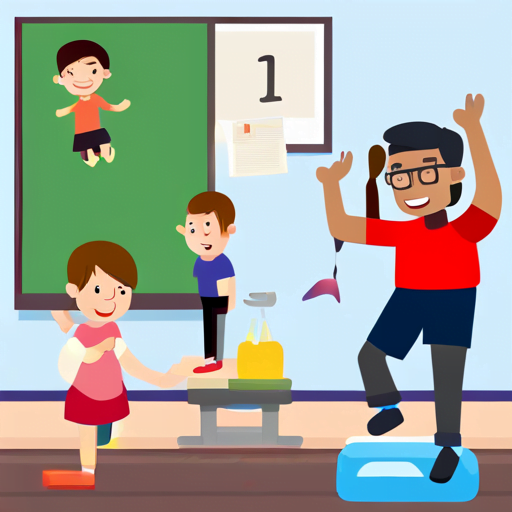Are you looking for ways to make your reading fluency exercises more engaging? One simple solution is to incorporate movement into your lessons. By adding physical activity, you can help students stay focused and motivated as they practice reading aloud.
Not only does movement help students stay engaged, but it also has cognitive benefits. Studies have shown that physical activity can improve memory, attention, and learning. So, it’s a win-win situation for both you and your students.
In this article, we’ll explore the benefits of incorporating movement into reading fluency exercises, provide some simple movement exercises to try, and offer strategies for integrating movement into your lessons. By the end, you’ll have the tools you need to create engaging and effective reading fluency exercises.
Table of Contents
Benefits of Incorporating Movement into Reading Fluency Exercises

You’ll love the perks of adding some physical activity to your reading practice! Incorporating movement into reading fluency exercises can make the process more engaging, enjoyable, and effective.
Not only does physical activity help children burn off excess energy, but it also stimulates their brains and helps them focus better on the task at hand. By introducing simple movements like clapping, stomping, or jumping, children can learn to associate physical actions with words and phrases. This can help them remember the material better and improve their overall comprehension.
Additionally, incorporating movement into reading fluency exercises can help children build confidence and self-esteem. When they’re able to successfully perform the actions while reading, they feel a sense of accomplishment and pride.
Finally, adding movement to reading fluency exercises can make the learning process more fun and enjoyable. Children are more likely to engage with the material when they’re actively involved in the learning process. By making reading practice more interactive and dynamic, children are more likely to stay interested and motivated to continue improving their reading skills.
So, why not try adding some movement to your reading fluency exercises today? Your child will thank you for it!
Simple Movement Exercises

Get your body moving with these easy exercises that’ll help you improve your reading skills. Incorporating movement into your reading fluency exercises is a great way to keep your body and mind engaged.
Here are some simple movement exercises that you can do while reading aloud to improve your fluency:
– First, try standing up and pacing back and forth while reading aloud. This’ll help you stay alert and focused on the text.
– You can also try walking in place or doing simple stretches to keep your body moving.
– Another great exercise is to tap your feet or clap your hands to the rhythm of the text. This’ll help you develop a sense of timing and pacing, which is essential for fluent reading.
Remember, incorporating movement into your reading fluency exercises doesn’t have to be complicated or time-consuming. Even simple exercises like standing up and pacing back and forth can make a big difference in your reading skills.
So next time you’re practicing your reading fluency, try incorporating some movement exercises to keep your body and mind engaged. With practice, you’ll find that your reading skills’ll improve, and you’ll become a more confident and fluent reader.
Strategies for Integrating Movement into Reading Fluency Exercises

By adding physical activity to your reading practice, you can enhance your comprehension and develop a more engaging and dynamic approach to improving your fluency.
One strategy for incorporating movement into reading fluency exercises is to use gestures and hand motions to emphasize key words or phrases. For example, when reading a sentence like “The cat jumped over the fence,” you could use your hands to mimic the cat jumping over an imaginary fence. This not only helps to reinforce the meaning of the sentence but also adds a fun and interactive element to the exercise.
Another strategy is to use movement breaks in between reading passages. This could involve standing up and doing a few stretches or walking around the room for a few minutes. Movement breaks can help to increase blood flow and oxygen to the brain, which can improve focus and concentration. Additionally, they provide a mental and physical break from the reading, which can help to prevent boredom or burnout.
Finally, consider incorporating more physical activities into your reading practice, such as acting out scenes from a story or using props to illustrate concepts. For example, you could use a toy car to demonstrate the concept of speed while reading about a race, or act out a scene from a play while reading the script. By making reading a more physical and interactive experience, you can engage multiple senses and enhance your overall comprehension and fluency.
Additional Tips for Making Reading Fluency Exercises More Engaging

If you want to make your reading fluency exercises more engaging, there are a few things you can do.
First, try incorporating games and interactive activities into your lessons. This will help to keep your students interested and motivated.
Second, consider using technology to enhance the learning experience. There are many apps and programs available that can help your students improve their reading skills.
Finally, make sure to encourage student participation and feedback. This will help your students to feel invested in their own learning and give you valuable insights into what’s working and what’s not in your lessons.
Including Games and Interactive Activities
You can enhance your reading fluency sessions by introducing interactive games that encourage physical activity. One way to do this is by incorporating movement breaks throughout the reading exercise. For example, you can have your students stand up and do jumping jacks or stretch their arms after every few pages read. This not only adds a physical element to the exercise but also helps break up the monotony of sitting and reading for an extended period.
Another way to incorporate movement into reading fluency exercises is by playing games that require physical activity. For instance, you can create a game where students have to act out the words they read from a book. This not only helps improve reading fluency but also promotes creativity and imagination.
Additionally, you can have students play a game of ‘musical chairs’ where they have to switch seats and read aloud from a different section of the book each time the music stops. These types of interactive activities can make reading fluency sessions more engaging and enjoyable for students.
Using Technology to Enhance the Learning Experience
You’ll love how technology can take your reading sessions to the next level and make learning more exciting and interactive.
There are many ways you can incorporate technology into your fluency exercises. For example, you can use websites like Fluency Tutor or ReadTheory to give students access to online reading passages and quizzes. These programs track student progress and provide feedback, allowing you to monitor each student’s progress individually.
Another way to use technology is through educational apps and games. Apps like Epic! and Reading Eggs offer a wide range of digital books and activities that can help students improve their reading fluency. These apps are perfect for independent practice, and many of them offer built-in rewards and incentives to keep students engaged.
By using technology in your fluency exercises, you can provide students with new and exciting ways to practice their reading skills while keeping them motivated and engaged.
Encouraging Student Participation and Feedback
Let’s find creative ways to get students involved and hear their thoughts on their reading progress. Encouraging student participation and feedback is crucial in ensuring that students stay engaged and motivated when it comes to reading fluency exercises.
One way to do this is by incorporating movement into the exercises. Instead of simply having students read aloud, try having them act out the story as they read. This not only helps with comprehension but also makes the exercise more enjoyable and interactive.
You can also have students take turns being the ‘teacher’ and leading the exercise, which gives them a sense of ownership and responsibility. Lastly, don’t forget to ask for feedback and suggestions on how to improve the exercises. Students are more likely to stay engaged when they feel like their opinions and thoughts are valued.
Overall, incorporating movement and encouraging participation and feedback can make a big difference in the effectiveness of reading fluency exercises. By getting students excited and involved, you can help them develop a love for reading and improve their fluency skills at the same time.
Frequently Asked Questions
What are some common challenges that students face when it comes to reading fluency exercises?
When it comes to reading fluency exercises, many students face common challenges that can hinder their progress.
One of the biggest obstacles is difficulty with word recognition and decoding, which can slow down their reading speed and comprehension.
Other students may struggle with maintaining focus and attention, leading to errors and lack of engagement with the material.
Additionally, some students may feel self-conscious or anxious about their reading abilities, which can further impede their progress.
By understanding these challenges and tailoring exercises to address them, educators can help students improve their fluency and confidence in reading.
How can incorporating movement into reading fluency exercises improve students’ overall reading abilities?
To improve your overall reading abilities, incorporating movement into your reading fluency exercises can be highly effective.
By engaging in physical activities while reading, your brain is able to make stronger connections between the words you’re reading and the actions you’re performing.
This can help increase your focus, comprehension, and retention of the material.
Additionally, incorporating movement into reading exercises can make the process more enjoyable and less monotonous, which can help keep you motivated and engaged in the learning process.
Are there any specific age groups or learning levels that benefit more from incorporating movement into reading fluency exercises?
When it comes to incorporating movement into reading fluency exercises, there are certain age groups and learning levels that may benefit more than others. For younger students, incorporating physical movements and gestures can help them better understand and retain information, as well as improve their overall reading abilities.
For older students, incorporating movement can help break up the monotony of traditional reading exercises and keep them engaged and motivated to continue practicing. Regardless of age or learning level, incorporating movement can add an element of fun and creativity to reading fluency exercises and make the learning experience more enjoyable for everyone involved.
Can movement be incorporated into group reading activities or is it best suited for individual practice?
If you want to make reading activities more engaging and effective, incorporating movement is a great idea. But the question is whether group reading activities can benefit from movement or if it’s better suited for individual practice.
The answer is that movement can absolutely be incorporated into group reading activities! In fact, it can be even more fun and effective to do so. You can have students act out scenes from the book they’re reading, use props to bring the story to life, or even do simple exercises like jumping jacks or stretches in between reading sessions.
The key is to make sure the movements are related to the text and don’t distract from the reading itself. With a little creativity, you can easily incorporate movement into your group reading activities and help your students become more engaged and fluent readers.
How can teachers ensure that movement activities are accessible for students with physical disabilities or limitations?
To ensure that movement activities are accessible for students with physical disabilities or limitations, you can modify the activities to fit their needs.
For example, instead of having students jump or run, you can have them do seated exercises or use arm movements. You can also provide alternative equipment, such as resistance bands or hand weights, for students who may not be able to use traditional equipment.
Additionally, it’s important to communicate with the student and their parents to understand any specific limitations or accommodations they may need. By making these modifications and accommodations, you can create an inclusive environment where all students can participate in movement activities.
Conclusion
So, there you have it! By incorporating movement into your reading fluency exercises, you can help engage your students and improve their reading skills.
The benefits of movement-based learning are numerous, from increased focus and attention to improved memory retention.
Remember to start with simple movements, like stretching or standing up and sitting down, before moving on to more complex exercises. And don’t forget to use strategies like call and response or incorporating music to keep things interesting.
By making reading fluency exercises more engaging, you can help your students become more confident and successful readers.
So get moving and start incorporating movement-based learning into your classroom today!
